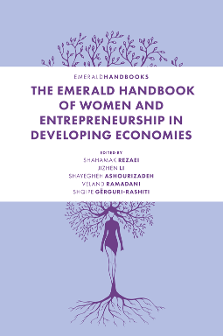
Index
The Emerald Handbook of Women and Entrepreneurship in Developing Economies
ISBN: 978-1-80071-327-7, eISBN: 978-1-80071-326-0
Publication date: 16 June 2021
Citation
(2021), "Index", Rezaei, S., Li, J., Ashourizadeh, S., Ramadani, V. and Gërguri-Rashiti, S. (Ed.) The Emerald Handbook of Women and Entrepreneurship in Developing Economies, Emerald Publishing Limited, Leeds, pp. 409-418. https://doi.org/10.1108/978-1-80071-326-020211022
Publisher
:Emerald Publishing Limited
Copyright © 2021 by Emerald Publishing Limited
INDEX
- Prelims
- Part 1 Conceptual Understanding of Woman Entrepreneurship in Developing Economies
- Chapter 1 Women Entrepreneurship Footprints: Some Introductory Reflections from Emerging Economies Prospects
- Chapter 2 Entrepreneurship and Innovation Emancipation among Women Entrepreneurs in Developing Countries
- Chapter 3 Gender Roles in Developing Countries and Women Entrepreneurs’ Intention/Entry/Business Engagement and Performance
- Chapter 4 Gender Diversity, Environmental Performances, and the Role of Countries' Development Status
- Part 2 Institutions, History, Culture as Catalysator or Blockage for Woman Entrepreneurship
- Chapter 5 Female Entrepreneurship in Latin America and the Key Role of Informal Institutions in the Reproduction of Gender Asymmetries
- Chapter 6 Women Entrepreneurship in Developing Countries: With Focus on GCC and Kuwait
- Chapter 7 Exploring Contextual Influences on Women's Everyday Entrepreneuring: A Case from China
- Chapter 8 The Role of Gender and Institutional Factors for Entrepreneurs and Corporate Entrepreneurs in Latin American Countries
- Chapter 9 Women Entrepreneurs and the Challenge of Work–Life Balance: Evidence from Kosovo
- Chapter 10 The Institutional History of Women Entrepreneurship in Modern Persia: A Socio-historicism Approach
- Chapter 11 Female Entrepreneurship à Brasileira: Entrepreneurship by Choice or Entrepreneurship by Force?
- Chapter 12 Women Entrepreneurship in Developing Countries: The Context of Afghanistan
- Chapter 13 Cultural Challenges of Women Entrepreneurs in Iran
- Chapter 14 Gendered Social Capital in Developing Countries: The Case of Turkey
- Part 3 Entrepreneurial Ecosystem and Female Digital Entrepreneurship
- Chapter 15 Digital Natives' Entrepreneurial Mindset: A Comparative Study in Emerging Markets
- Chapter 16 Entrepreneurial Ecosystem and Female Digital Entrepreneurship – Lessons to Learn from an Iranian Case Study
- Chapter 17 Networking Activity of Female Entrepreneurs Over Time: An Exploratory Case Study on Female Entrepreneurs from Early-Stage to Establishment
- Part 4 Early-stage Female Entrepreneurship, Drivers, and Outcomes
- Chapter 18 Lessons from Global Financial Crisis: Human Capital and Business Activities among Nascent Women Entrepreneurs in China
- Chapter 19 Innovation Amplifies Growth Ambitions of Early-Stage Female Entrepreneurs: More in Nordics, Less in MENA Region
- Chapter 20 Empowering Women through Microfinance Banks in Rural Areas of Pakistan
- Index